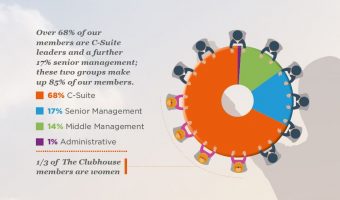News from in & around
The Clubhouse
How to become a more human leader
Leadership expert Rasmus Hougaard explores why people-centric cultures create more fulfilled and engaged employees

As human beings, we are all driven by basic needs for meaning, happiness, human connectedness, and a desire to contribute positively to others. Leaders that truly understand these needs, and lead in a way that enables these intrinsic motivations, have the keys to enable strong loyalty, engagement and performance. There is a vast upside to human leadership. As data from McKinsey & Company shows, when employees are intrinsically motivated, they are 32% more committed, 46% more satisfied with their job and perform 16% better. The problem, however, is about 70% of leaders rate themselves as inspiring and motivating – much in the same way as we all rate ourselves as great drivers. But this stands in stark contrast to how employees perceive their leaders.
A survey published by Forbes found that 65% of employees would forego a pay raise if it meant seeing their leader fired, and a 2016 Gallup engagement survey found that 82% of employees see their leaders as fundamentally uninspiring. In our opinion, these two things are directly related. Our research at Potential Project showed that a global movement is taking place amongst the C-suite of thousands of progressive organisations like Accenture, Marriott, Starbucks, Microsoft and LinkedIn. The leaders of these organisations ask themselves, “How can we create more human leadership and peoplecentred cultures where employees and leaders are more fulfilled and fully engaged?”
Based on our work in creating more human leaders, here are a few tips:
Be personal
Bob Chapman, CEO of Barry Wehmiller, a global manufacturing company, and author of Everybody Matters, has gone to great lengths to instil truly human leadership within the company. For all decisions being made that have impact on employees, he asks himself: if my child or parent or good friend worked here, would they appreciate this decision? In this way he makes a managerial decision a personal question. Try the same when making decisions affecting your people.
Be self-aware
Leadership pioneer Peter Drucker said, “You cannot manage other people unless you manage yourself first.” When you understand yourself, you are better able to understand and empathise with the people you lead, and in turn lead for their intrinsic motivation. Good leadership starts with self-awareness, and self-awareness can be greatly enhanced through the practice of mindfulness.
Be selfless
Dominic Barton, global managing director of McKinsey & Company, says that selflessness is the foundation of good leadership. Leadership is not about you, but about the people and the organisation you lead. With selflessness, you take yourself out of the equation and consider the long-term benefits of others. Selflessness does not mean you become a doormat for others and refuse to stand up for yourself. Selflessness comes out of self-confidence and self-care. When you make decisions, check your motivation – are you doing it for personal gain, or for the benefits of others?
Be compassionate
Compassion is the intention to bring happiness to others. If you have ever had a leader that was compassionate, you will know what it feels like. The person has your interest in mind. As a result, you feel safe, trusted, loyal, and committed. When it comes to leadership, nothing beats compassion. It is a universal language that is understood by anyone, anywhere. If you want to bring more compassion into your leadership, make a habit of asking one simple question whenever you engage with anyone: how can I help this person have a better day?
To hear Potential Project discuss this topic in more detail, join us at our Members’ Breakfast on 21 May.
Rasmus Hougaard is the founder and managing director of Potential Project, a global leadership and organisational development firm serving Microsoft, Accenture, Cisco and hundreds of other organisations. He is the author of The Mind of the Leader – How to Lead Yourself, Your People and Your Organisation for Extraordinary Results with HBR Press in March 2018.
This article was originally featured in The Informer – May 2019. To read the full magazine please click here


